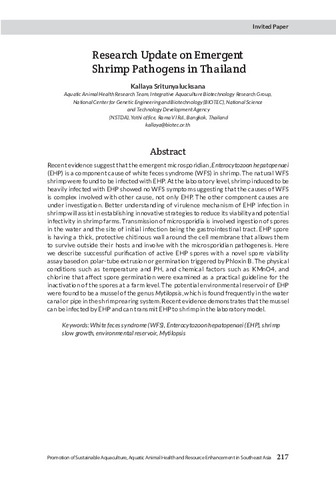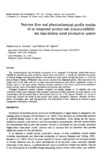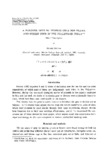Research update on emergent shrimp pathogens in Thailand
- Global styles
- MLA
- Vancouver
- Elsevier - Harvard
- APA
- Help
Share
Abstract
Recent evidence suggest that the emergent microsporidian, Enterocytozoon hepatopenaei (EHP) is a component cause of white feces syndrome (WFS) in shrimp. The natural WFS shrimp were found to be infected with EHP. At the laboratory level, shrimp induced to be heavily infected with EHP showed no WFS symptom suggesting that the causes of WFS is complex involved with other cause, not only EHP. The other component causes are under investigation. Better understanding of virulence mechanism of EHP infection in shrimp will assist in establishing innovative strategies to reduce its viability and potential infectivity in shrimp farms. Transmission of microsporidia is involved ingestion of spores in the water and the site of initial infection being the gastrointestinal tract. EHP spore is having a thick, protective chitinous wall around the cell membrane that allows them to survive outside their hosts and involve with the microsporidian pathogenesis. Here we describe successful purification of active EHP spores with a novel spore viability assay based on polar-tube extrusion or germination triggered by Phloxin B. The physical conditions such as temperature and PH, and chemical factors such as KMnO4, and chlorine that affect spore germination were examined as a practical guideline for the inactivation of the spores at a farm level. The potential environmental reservoir of EHP were found to be a mussel of the genus Mytilopsis, which is found frequently in the water canal or pipe in the shrimp rearing system. Recent evidence demonstrates that the mussel can be infected by EHP and can transmit EHP to shrimp in the laboratory model.
Description
Abstract only.
Suggested Citation
Sritunyalucksana, K. (2021). Research update on emergent shrimp pathogens in Thailand. In F. A. Aya, L. D. de la Peña, N. D. Salayo, & E. A. Tendencia (Eds.), Proceedings of the International Workshop on the Promotion of Sustainable Aquaculture, Aquatic Animal Health, and Resource Enhancement in Southeast Asia (p. 217). Tigbauan, Iloilo, Philippines: Aquaculture Department, Southeast Asian Fisheries Development Center.
Type
Conference paperISBN
9789719931102 (Print); 9789719931119 (PDF)
Except where otherwise noted, this item's license is described as Attribution-NonCommercial-ShareAlike 3.0 IGO
Related items
Showing items related by title, author, creator and subject.
-
Asian shrimp situation
Carreon-Lagoc, Julia; Southeast Asian Fisheries Development Center, Aquaculture Department (Aquaculture Department, Southeast Asian Fisheries Development Center, 1990) -
Nutrient flow and physicochemical profile studies of an integrated poultry-salt-Artemia-milkfish-sea bass-shrimp pond production system
Jumalon, Nepheronia A.; Ogburn, Damian M. (Wetteren, Belgium: Universal Press, 1987)The physicochemical and biological parameters of an integrated flow-through poultry-salt-Artemia-milkfish-sea bass-shrimp pond production system were monitored for 6 months to determine the pattern of nutrient changes and ... -
A further note to “fishing gear for prawn and shrimp used in the Philippines today”
Motoh, Hiroshi (Carcinological Society of Japan, 1983)Motoh (1980) reported 9 and 13 kinds of shrimping gear for the fry and the adult respectively, of which most of them are indigenously used today in the Philippines. Howerver, druing the continued ecological survey of ...







